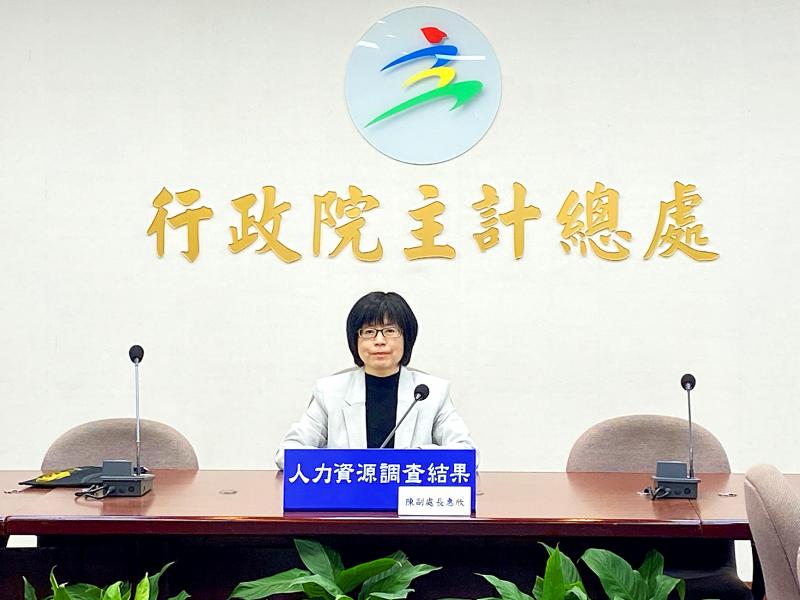The nation’s unemployment rate last month dropped to 3.66 percent, falling for the sixth straight month, as fewer people quit their jobs, but slightly more than left seasonal or temporary positions, the Directorate-General of Budget, Accounting and Statistics (DGBAS) said yesterday.
The rate was the lowest in 12 months, but remained at a four-year high for January, as the job market has not yet fully recovered from the COVID-19 pandemic, DGBAS Deputy Director Chen Hui-hsin (陳惠欣) told a media briefing.
“Unemployment usually declines in January, but could rise this month as people disatisfied with their jobs tend to move on after receiving their year-end bonus,” Chen said.

Photo: Cheng Chi-fang, Taipei Times
This trend was disrupted last year as the COVID-19 outbreak weakened economic activity and people did not seek new positions over economic fears.
The jobless rate after seasonal adjustments held steady at 3.75 percent, suggesting a stable market, Chen said.
The number of jobless people shrank by 0.52 percent, or 2,000, to 438,000 last month, the agency’s monthly report showed.
While about 3,000 fewer first-time jobseekers entered the market and about 1,000 fewer people entered after quitting their jobs, 2,000 people left their temporary positions, it showed.
The labor participation rate was 59.14 percent, unchanged from December last year and down 0.07 percentage points year-on-year, it said.
The unemployment period averaged 22.2 weeks, longer than the 22.1 weeks one month earlier, it said, adding that the period for first-time jobseekers shrank to 21.1 weeks.
People with university degrees had the highest unemployment rate at 5.33 percent, followed by high-school graduates at 3.35 percent and people with other graduate degrees at 2.86 percent, the report showed.
People with a junior-college education had the lowest unemployment rate at 2.5 percent, followed by those with a junior-high school education at 2.67 percent, it showed.
People aged 20 to 24 had the highest unemployment rate at 11.96 percent, followed by 15 to 19-year-olds at 8.4 percent, 25 to 29-year-olds at 6.22 percent and 30 to 34-year-olds at 3.58 percent, the report showed.
People aged 45 to 64 had the lowest unemployment rate of 2.16 percent, it showed.
The nation’s unemployment rate is lower than South Korea’s 5.7 percent, Hong Kong’s 6.5 percent and Germany’s 4.4 percent, but higher than Japan’s 2.8 percent, government data showed.

TECH BOOST: New TSMC wafer fabs in Arizona are to dramatically improve US advanced chip production, a report by market research firm TrendForce said With Taiwan Semiconductor Manufacturing Co (TSMC, 台積電) pouring large funds into Arizona, the US is expected to see an improvement in its status to become the second-largest maker of advanced semiconductors in 2027, Taipei-based market researcher TrendForce Corp (集邦科技) said in a report last week. TrendForce estimates the US would account for a 21 percent share in the global advanced integrated circuit (IC) production market by 2027, sharply up from the current 9 percent, as TSMC is investing US$65 billion to build three wafer fabs in Arizona, the report said. TrendForce defined the advanced chipmaking processes as the 7-nanometer process or more

China’s Huawei Technologies Co (華為) plans to start mass-producing its most advanced artificial intelligence (AI) chip in the first quarter of next year, even as it struggles to make enough chips due to US restrictions, two people familiar with the matter said. The telecoms conglomerate has sent samples of the Ascend 910C — its newest chip, meant to rival those made by US chipmaker Nvidia Corp — to some technology firms and started taking orders, the sources told Reuters. The 910C is being made by top Chinese contract chipmaker Semiconductor Manufacturing International Corp (SMIC, 中芯) on its N+2 process, but a lack

NVIDIA PLATFORM: Hon Hai’s Mexican facility is to begin production early next year and a Taiwan site is to enter production next month, Nvidia wrote on its blog Hon Hai Precision Industry Co (鴻海精密), the world’s biggest electronics manufacturer, yesterday said it is expanding production capacity of artificial intelligence (AI) servers based on Nvidia Corp’s Blackwell chips in Taiwan, the US and Mexico to cope with rising demand. Hon Hai’s new AI-enabled factories are to use Nvidia’s Omnivores platform to create 3D digital twins to plan and simulate automated production lines at a factory in Hsinchu, the company said in a statement. Nvidia’s Omnivores platform is for developing industrial AI simulation applications and helps bring facilities online faster. Hon Hai’s Mexican facility is to begin production early next year and the

Who would not want a social media audience that grows without new content? During the three years she paused production of her short do-it-yourself (DIY) farmer’s lifestyle videos, Chinese vlogger Li Ziqi (李子柒), 34, has seen her YouTube subscribers increase to 20.2 million from about 14 million. While YouTube is banned in China, her fan base there — although not the size of YouTube’s MrBeast, who has 330 million subscribers — is close to 100 million across the country’s social media platforms Douyin (抖音), Sina Weibo (新浪微博) and Xiaohongshu (小紅書). When Li finally released new videos last week — ending what has